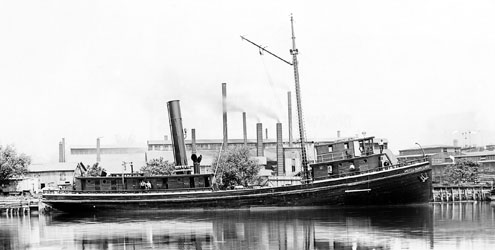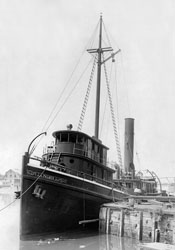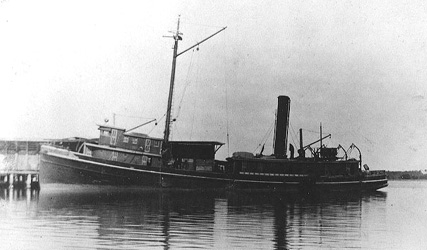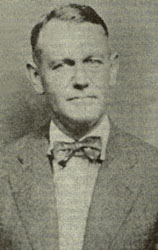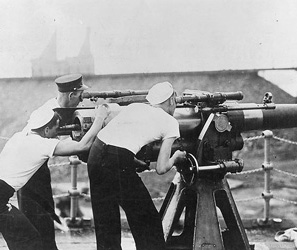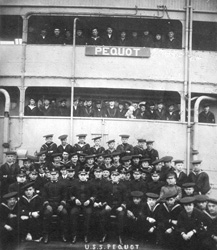
USCG CABLE SHIP PEQUOT - UNITED STATES HARBOR DEFENCES
THE 'OTHER' PEQUOTS
This page tells the story of some other ships with the name Pequot. It provides an historical link to another Pequot - the U.S. Coast Guard Cable ship Pequot that served the United States during World War II as a harbor defense cable-laying and repair ship under direction of the US Navy. The main site for the USGC Pequot can be found at indicatorloops.com/usn_pequot.htm. That site presents details of the ship's Top Secret mission of laying anti-submarine indicator loop cables and the history of the ship during the Battle of the Atlantic. Extensive photos and text have been provided by the sailors who served on the Pequot and their families, and many of their personal stories are included. Also available are pages from the Harbor Defense Manual describing the duties of the Pequot. There are links to indicator loop technical pages, the construction of the ship in 1909, and to the personal story of the Pequot's Captain. We hope you enjoy reading about the "Other" Pequots.
The 1st USCG Pequot Cable Ship
In 1916, when the first World War in Europe became America's business, it was recommended that the various means of communication being used along the coast be coordinated and that the Coast Guard, then being the existing telephone system of coastal communications, be brought up to a high state of efficiency. It was necessary to lay submarine communication cables to achieve this. However, in WW1, the Coast Guard had no cable ship and what little cable laying was done was accomplished by the Western Union cable ship Robert C. Clowry and the converted 282 gross ton menhaden fishing trawler, John A. Palmer Jr. (SP-319), which was operated by the US Navy.
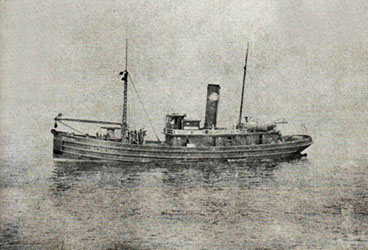 |
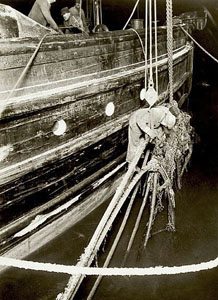 |
2a. The only known photo of
the Robert C. Clowry.
(Courtesy Bill Burns - from
Kenneth Haigh's "Cableships & Submarine Cables") |
2b. Crew from the Robert C Clowry
untangling telephone cables in 1916 while working for the American
Telephone & Telegraph Company. (Rosenfeld Collection Mystic Seaport
Museum) |
The Clowry was built by A.C. Brown in 1910 in
Tottenville, New York with a length of 132' and a beam of 33'. She was
owned and operated by the Western Union Telegraph Company as a cable
layer. Between 1919 and 1924 she ran each year from Halifax, Nova Scotia
to New York where her foreign crew was processed through Ellis Island
whenever they entered port. After Western Union sold the Clowry in 1924
the new owners painted "Western Union" in big letters on her
superstructure and used the ship as a rum runner during prohibition
which resulted in Western Union being accused of bootlegging! She was
sold again in 1926 and renamed Telegraph before being sold in 1930 and
renamed Salvor. The ship was scrapped in 1938.
Anne Rodda's book on genealogy and family history features her grandfather who was the Chief Officer of the Clowry, see Trespassing in Time: Family History as Microhistory.
The Palmer was built in 1911 by the Jackson & Sharp Company of Wilmington, Delaware. She displaced 276 tons, had a length of 155', a beam of 22' and a top speed of 12 knots. The ship was named for John Armistead Palmer Jr. who was one of the most innovative menhaden [a species of fish] fishing operators of the period.
Palmer was the first to add refrigerated holds to menhaden ships to reduce spoilage, and he first used ship-to-shore wireless communications to alert fish processing plants when boats laden with the latest catch would be arriving. The Palmer Fisheries first experimented with burning oil on menhaden fishing trawlers to generate steam instead of coal and he pioneered the use of packing plant scraps as fish meal to feed livestock. A true visionary he even convinced the Navy to make a US Navy flying boat available to test if aerial observations could spot schools of fish off the US coast. While the experiment proved very successful and established that schools of fish could be located from the air and their locations radioed to fishing company shore stations, it proved too expensive a practice to implement at the time. In retrospect many felt ingenious Palmer was 50 to 75 years ahead of his time. Many of his unique concepts from the early 1900s are standard practice today.
The Navy acquired the John A. Palmer Jr. trawler from the C. E. Davis Packing Company of Reedville, Virginia, on April 7th, 1917 for World War I service as a patrol vessel and armed her with two 1-pounder cannons. She was commissioned the same day as the USS J. A. Palmer (SP-319) with Boatswain W. A. Hudgins in command.Assigned to the 5th Naval District, J. A. Palmer served on patrol duty
off Cape Henry, Virginia, until February 1918, when she received special cable
equipment at Berkeley, Virginia. She then was loaned to the United States Coast
Guard for use along the East coast laying and repairing cable. To avoid
confusion with the destroyer USS Palmer (DD-161), J. A. Palmer's name was
dropped on January 17th 1919, and she became the USS SP-319. She was
transferred to the Coast Guard on September 10th 1919 and served as the cable
ship Pequot until 1922. She towed her replacement vessel, the former Army
mine planter General Samuel M. Mills, from Newport News, Virginia to the
Depot at Curtis Bay on April 28th 1922. The 1st Pequot cable ship was
decommissioned on May 11th 1922 and was sold on August 8th 1922 to McNeal
Edwards Company, of Reedville, Virginia for $17,000.
The Other Pequots
In honor of the Native America tribe of Southern Connecticut two other United States ships were named the Pequot. The Pequots are members of the Algonquian language grouping who believe that every living thing in the earth has a spirit and that One Great Spirit oversees everything. By 1990 there were only 680 Pequot remaining in the United States.
The Civil War Pequot. The first USS Pequot was a 600 ton Nipsic Class US Civil War wooden screw gunboat built in 1862 by Woodruff of Portsmouth, New Hampshire. She was launched in June 1863 at the Boston Navy Yard and commissioned in 1864 when she joined the North Atlantic Blockading Squadron under the command of Rear Admiral Stephen Platt Quackenbush. Ordered by the Navy Department as an emergency measure, and built rapidly of unseasoned timber Pequot and her sister ships were known as "90-day Gunboats." Designed by S. M. and S. H. Pook with engines by Isherwood these two-masted schooners did poorly under sail, but performed well while steaming. With a deadweight of 836 tons she was armed with one 150-pounder Parrott Rifle, one 30-pounder Parrott Rifle, two 9" Dahlgren smooth bore cannons, two 24-pounder Howitzers, and one smooth bore 12-pounder cannon.
Under Quackenbush she captured the British blockade runner, Don, off Beaufort, North Carolina and helped the Army beat back a Confederate attack on Wilson's Wharf at James River, Virginia. Later she also engaged during the bombardment of Fort Fisher, North Carolina and helped capture Fort Anderson. Decommissioned after the Civil War in June 1865 she was sold to Haiti in 1869. In 1875 she was renamed the Terreur which means "The Terror" or "The Dread" in French.
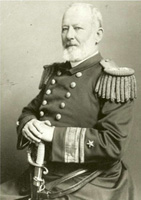 |
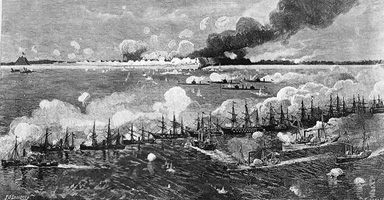 |
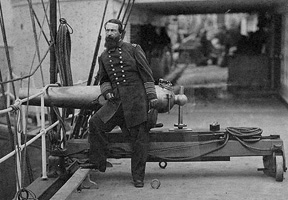 |
| 17. In August of 1864 after the
battle of Mobile Bay Rear Admiral Bancroft Gherardi was
given command of the U.S.S. Pequot. (U.S. Naval Historical Center Photograph NH 49305) |
18. The bombardment of Fort Fischer January 15th, 1865. (Engraving by J.O. Davidson) | 19.
Rear Admiral David Dixon Porter, Commander of the Pequot's
North Atlantic Blockading Squadron. (U.S. Naval Historical Center Photograph NH 91416. Photographed by Alexander Gardner) |
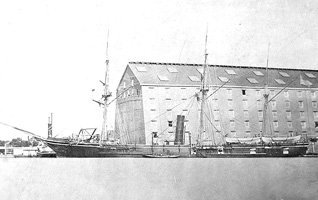 |
 |
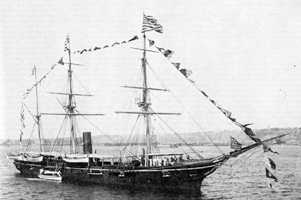 |
| 20. A Nipsic Class gunboat at the Washington Navy Yard,
District of Columbia, circa late 1860s. (U.S. Naval Historical Center Photograph NH 45212) |
21. Navy Rear Admiral Stephen Platt Quackenbush who was the
Pequot's first captain. (findagrave.com) |
22. The Pequot's sister ship - the 1864 Nipsic class gunboat USS Yantic. (U.S. Navy Dictionary of American Naval Fighting Ships Naval Historical Cente) |
The World War I Pequot.
The second Pequot (ID-2998) was a German freighter which displaced 12,500 tons, and was operated as the Ockenfels for the German Navy. She was built in 1910 by Joh C. Tecklenborg shipbuilding at Geestermunde, in the Bremen Region of Germany as build #235. The ship was launched on April 9th 1910. Powered by a quadruple expansion steam engine this single screw freighter typically traveled at 11 knots.
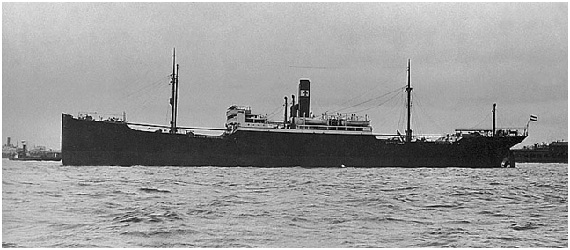 |
|
23. The Ockenfels ready for sea trials at Blexen, Germany on the River Weser after being launched at Geestermunde, circa 1910 (State Archives collection) |
On May 28th 1910 the ship was delivered to the German steamship company DDG Hansa out of Bremen. Hansa was a major German shipping company specializing in heavy freight. At 5,621 gross tons the Ockenfels ran 421 feet long with a beam 52 feet wide. To load and unload cargo she was constructed with one 25 ton derrick, eight 5 ton derricks, and three 3 ton derricks. She was designed and built for a crew of 63 officers and men.
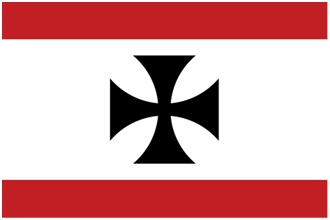 |
|
24. The distinctive "House Flag" of the DDG Hansa Steamship Company (Deutsche Dampfschifffahrts-Gesellschaft Hansa) which we see on the funnel of the Ockenfels when she first went into service in 1910 and then again when Hansa operated the freighter after WWI. ((wikimedia commons) |
In 1914 when World War I broke out, and the high seas were unsafe for German shipping, she took refuge and was interned in Boston. In April of 1917 when the US entered the war she was seized in New York by the Shipping Board of the US Government and became part of the American merchant marine. Prior to seizure her crew disabled the Okenfels' main engine rendering it useless. Once in American hands she was refurbished and taken over by the US Navy on October 28th 1918 and commissioned as the USS Pequot on the same day.
|
|
|
|
25. Gun crew bore sighting
the forward deck gun on the S.S Ockenfelds 1917. |
26. The Second Pequot: SS Ockenfels - 28 June 1917. (U.S. Naval Historical Center) |
She was assigned to the Naval Overseas Transportation Service and was used to carry general cargo on both the Army and Shipping Board accounts during the war. She was struck from the Navy List in July 1919 and returned to the Shipping Board.
|
27. The officers and crew of the
freighter USS Pequot taken in Rotterdam, Holland on
February 23rd, 1919. |
After WWI she ran cargo between Bermuda, Genoa, Italy and New York.
References indicate that during the early 1920s she was chartered at different
times to the Atlantic, Adriatic and SS Corporation cargo lines. In 1923 she was
sold to the California Steamship Company (Panama) and sailed under an American
flag.
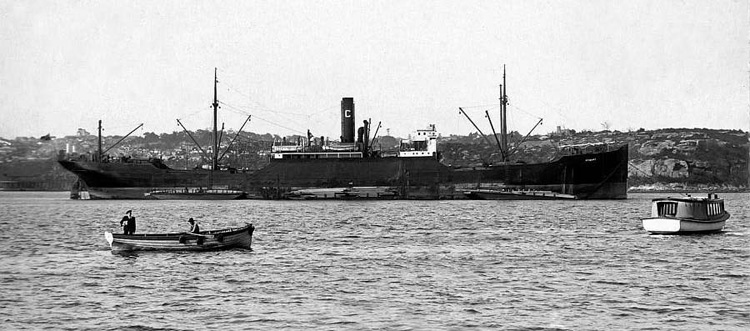 |
|
28. The freighter USS Pequot - date and harbor unknown. Based on the large "C" house flag on the funnel we speculate this photo was taken shortly after WWI when the ship was released from military service and sold to the California Steamship Company. (photoship.co.uk) |
 |
|
29. The Argenfels steaming into Hamburg, Germany on the Elbe River 1923-33 (Collection of Dr. Jurgen Meyer) |
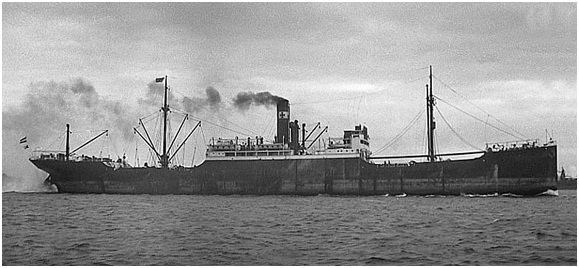 |
|
30. Here we see the Argenfels during her last 9 years at sea outbound from Hamburg, Germany on the Elbe River. (Photo: Jansen per Wolfgang Fuchs collection) |
DDG Hansa sold the Argenfels on December 24th 1932 to the Blohm & Voss Shipworks of Hamburg, Germany where she was scrapped in 1933.
Non-Military Pequots
Under sail or steam over the years numerous ships have been have been named Pequot. Historical ship index records provide references and citations to more than 25 different non-military craft that have served on the high seas or inland waterways during the past 150 years that were named in honor of the North American Indian tribe Pequot. Here are two examples from opposite ends of the 20th century.
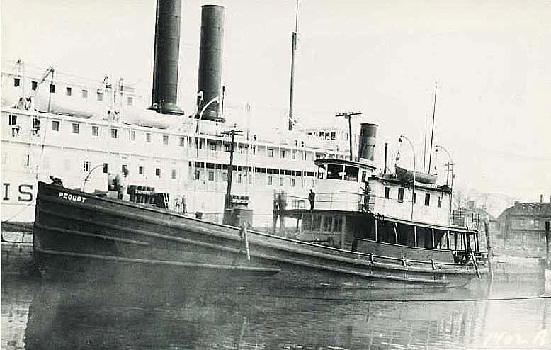 |
|
1. Moored next to a large passenger ferry this Pequot from the early 1900s without forward mast or booms appears to be a working harbor tug or auxiliary of some kind. (Historical Society of America, Thomas H. Franklin Collection) |
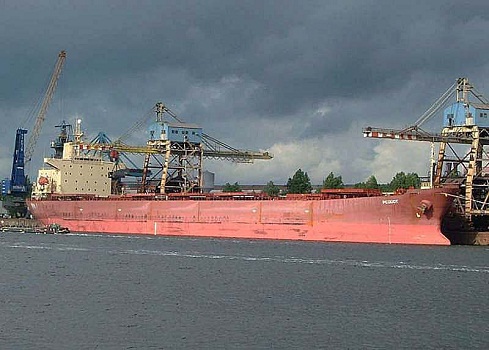 |
|
2. The bulk carrier Pequot in the Belgium/Netherlands Ghent Canal in 2004. Constructed by Sumitomo Heavy Industries in 1996 this 36,615 gross ton freighter operated worldwide as the Pequot under the Liberian Flag. In 2011 the ship was renamed The Bulk Patriot and began operating under the Panamanian flag. (Dave Medgett, shipspotting.com) |
 |
|
3. On November 6th 2005 while steaming across Lake Maracaibo in Venezuela the LPG Tanker M/T Maersk Holyhead loaded with 11,200 metric tons of propane steered directly in front of the Pequot resulting in a serious collision. (cargolaw.com) |
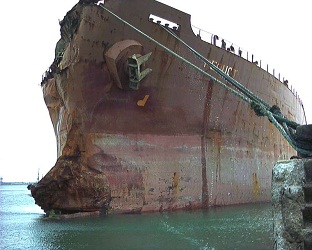 |
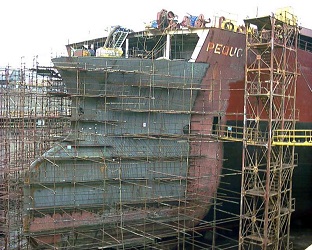 |
|
Despite a small fire both ships survived.
The bow of the Pequot had to be completely rebuilt. |
|
Every effort has been made to trace and acknowledge copyright. The authors would welcome any information from people who believe their photos have been used without due credit. Some photos have been retouched to remove imperfections but otherwise they are true to the original.
FEEDBACK
If you have comments or queries specifically
about the Pequot or her Escort Ships, please contact
Chip Calamaio chipaz@cox.net,
Phoenix, Arizona, USA. (H) 602-279-450.
Click here to go to the Pequot Main Page.
Research and design: Chip Calamaio and Richard Walding
